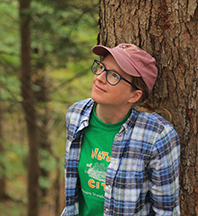Week of May 19, 2024 – May 25, 2024
by Anna Stunkel, Environmental Educator
Tomorrow, May 20, is an internationally recognized holiday in celebration of our pollinator friends, the bees! As I type this blog on the back deck of the nature center, the area is abuzz with activity. The familiar hum of bees is a welcome soundtrack of spring.
When many of us think of bees, honeybees might be the first ones that come to mind. But did you know that there are approximately 450 bee species in New York state? Our native bees tend to be much more effective pollinators than honeybees. A little over half of the species in the state are miner bees, meaning that they excavate tunnels in the ground. Female miner bees use a pollen and nectar mixture to feed their young inside the tunnels. They are very important pollinators, and some species are especially known for visiting spring ephemeral wildflowers like Trout Lilies and Spring Beauties.
At this time of year, you might notice bumblebee queens searching for nesting sites as they zigzag along close to the ground. These large, fuzzy bees have always been among my favorites. Bumblebees are known for buzz pollination, a very effective method that involves shaking pollen loose from flowers. They are the only truly social native North American bees, and like many social mammals and birds, bumblebees enjoy play. In a recent experiment, scientists found that bumblebees played with toy balls even when there is no external reward for this behavior. The bees were well-fed and chose to leave their food source in order to play with the balls many times.
Carpenter bees are also common at this time of year, and you might spot males hovering outside their tunnels. They often tunnel into wood on decks and kiosks. They are very territorial, and two of them even bumped into my head just the other day while battling in midair.
Bees play a crucial role not only as pollinators, but also as hosts for specific parasites that are other bee species. Bee burrows provide homes for a variety of other insects as well. The links between parasites, burrow-dwelling insects, host bees, and plants that are pollinated form a web of relationships within ecosystems.
Next time you visit a flower garden, see how many kinds of bees you can spot. Along with the classic yellow and black banded patterns, these insects come in a striking variety of colors from metallic green to rusty red. And next time you hear the phrase, “save the bees!” remember our huge variety of native bee pollinators, which deserve plenty of appreciation.


